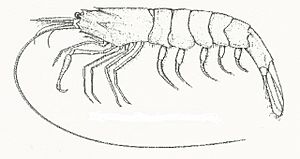Crangon franciscorum facts for kids
Quick facts for kids Crangon franciscorum |
|
|---|---|
 |
|
| Scientific classification | |
| Genus: |
Crangon
|
| Species: |
franciscorum
|
The Crangon franciscorum is a type of shrimp. It belongs to the Crangonidae family. This shrimp lives only in the brackish estuaries of California. You can find it from Puget Sound in the north all the way down to San Diego.
This shrimp is very common in San Francisco Bay. Even though its numbers change sometimes, it's still found there a lot. People call it by many names, like bay shrimp, sand shrimp, common shrimp, grass shrimp, black shrimp, California shrimp, and black tailed shrimp. People have been fishing for this shrimp to sell since 1869, and they still do today.
Contents
Bay Shrimp's Role in the Food Web
This shrimp is a very important part of the food chain in the San Francisco Bay area. It helps keep the bay healthy.
Bay shrimp eat small creatures like clams and oysters (called bivalves), amphipods, and tiny organisms called foraminiferins.
In turn, many other animals eat the bay shrimp. These include fish like striped bass, white sturgeon, and Pacific tomcod. Even shellfish like the Dungeness crab enjoy eating them. What the shrimp eat depends on how big they are, the water's temperature and saltiness, and what food is available.
Bay Shrimp Life Cycle
Bay shrimp do not live very long. Males usually live up to 18 months. Females can live longer, up to 30 months.
Male shrimp usually reproduce once. Females, because they live longer, can reproduce twice. There's a cool idea that some male shrimp might change into females after about a year. This is called protandrous hermaphroditism. This could explain why females live longer than males.
Water temperature and saltiness are super important for the shrimp's health. Young shrimp like water that is a little salty, about 14 parts per thousand (ppt). When they are ready to reproduce, they prefer water that is saltier, around 24 ppt. To compare, the open ocean is much saltier, about 35 ppt.
The shrimp also like water that is about 18°C (65°F). Because the bay's water temperature and saltiness change with the seasons, and with how much fresh water flows in from rain, the shrimp move around. They look for the best conditions. This is why their numbers can go up and down a lot.
When a lot of fresh water flows into the bay, older female shrimp move to saltier areas. They might go to the central bay or even out to the Golden Gate and the Gulf of the Farallones. There, they meet males who like slightly saltier water.
After mating, the females carry 2,000 to 8,000 eggs. When the baby shrimp hatch, they swim back to the shallower, less salty parts of the bay. As the young shrimp grow, they slowly move to deeper, cooler, and saltier water.
Challenges for Bay Shrimp
Bay shrimp are sensitive to pollution. When scientists put them in water with sewage in a lab, the shrimp tried to get away from it. This shows they don't like dirty water.
In the late 1800s and early 1900s, San Francisco Bay became very polluted. The Gold Rush caused some of the first big problems. Miners used a method called hydraulic mining. This sent millions of cubic meters of rock and dirt into the Sacramento and San Joaquin Rivers. These rivers are the main source of fresh water for the bay. All that dirt built up on the bottom of the bay. This made the bay smaller and changed how the tides worked. Hydraulic mining was stopped by a court in 1884.
The size of the bay also got smaller as people built walls to create farms and salt ponds. Some parts of the bay were filled in to make land for buildings. Examples include San Francisco's Marina District, Treasure Island, and Foster City. By the 1980s, most of the natural marshlands around the bay were gone. These marshes are where the shrimp like to live.
Big water projects, like the Central Valley Project (started in 1933) and the California State Water Project (started in 1960), also affected the bay. These projects used dams, reservoirs, and canals to move water from the Sacramento and San Joaquin Rivers. The water was used for farms and cities. By the 1980s, the amount of fresh water flowing into the bay each year was only about 40% of what it used to be.
When there are long periods of dry weather, the shrimp population goes down. After wet years, their numbers bounce back. For example, in 1996, after two wet years, there were 20 times more shrimp than in 1980, which followed a very dry period.
Fishing for Bay Shrimp
In the 1800s, this shrimp was the most common type of shrimp in San Francisco Bay. It was also the most important for commercial fishing from the 1870s to the 1930s. About 90% of all the shrimp caught were Crangon franciscorum.

